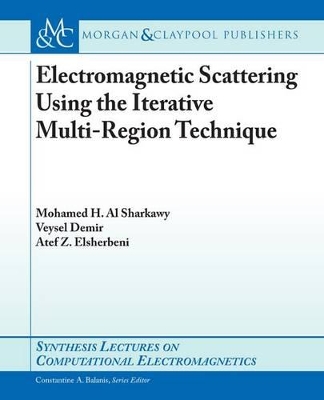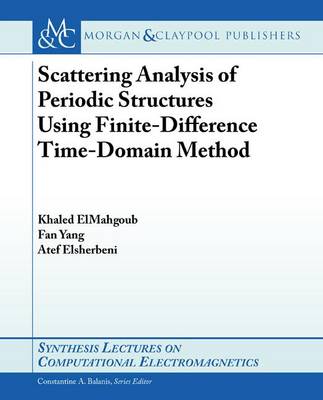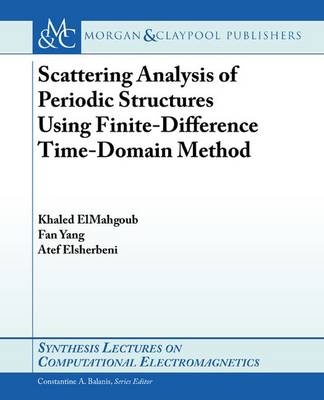Synthesis Lectures on Computational Electromagnetics
6 total works
Double-Grid Finite-Difference Frequency-Domain (Dg-Fdfd) Method for Scattering from Chiral Objects
by Erdogan Alkan, Veysel Demir, Atef Z. Elsherbeni, and Ercument Arvas
Published 1 January 2013
This book presents the application of the overlapping grids approach to solve chiral material problems using the FDFD method. Due to the two grids being used in the technique, we will name this method as Double-Grid Finite Difference Frequency-Domain (DG-FDFD) method. As a result of this new approach the electric and magnetic field components are defined at every node in the computation space. Thus, there is no need to perform averaging during the calculations as in the aforementioned FDFD technique [16]. We formulate general 3D frequency-domain numerical methods based on double-grid (DG-FDFD) approach for general bianisotropic materials. The validity of the derived formulations for different scattering problems has been shown by comparing the obtained results to exact and other solutions obtained using different numerical methods.
Multiresolution Frequency Domain Technique for Electromagnetics
by Mesut Goekten, Atef Elsherbeni, and Ercument Arvas
Published 1 October 2012
In this book, a general frequency domain numerical method similar to the finite difference frequency domain (FDFD) technique is presented. The proposed method, called the multiresolution frequency domain (MRFD) technique, is based on orthogonal Battle-Lemarie and biorthogonal Cohen-Daubechies-Feauveau (CDF) wavelets. The objective of developing this new technique is to achieve a frequency domain scheme which exhibits improved computational efficiency figures compared to the traditional FDFD method: reduced memory and simulation time requirements while retaining numerical accuracy.
The newly introduced MRFD scheme is successfully applied to the analysis of a number of electromagnetic problems, such as computation of resonance frequencies of one and three dimensional resonators, analysis of propagation characteristics of general guided wave structures, and electromagnetic scattering from two dimensional dielectric objects. The efficiency characteristics of MRFD techniques based on different wavelets are compared to each other and that of the FDFD method. Results indicate that the MRFD techniques provide substantial savings in terms of execution time and memory requirements, compared to the traditional FDFD method.
The newly introduced MRFD scheme is successfully applied to the analysis of a number of electromagnetic problems, such as computation of resonance frequencies of one and three dimensional resonators, analysis of propagation characteristics of general guided wave structures, and electromagnetic scattering from two dimensional dielectric objects. The efficiency characteristics of MRFD techniques based on different wavelets are compared to each other and that of the FDFD method. Results indicate that the MRFD techniques provide substantial savings in terms of execution time and memory requirements, compared to the traditional FDFD method.
Electromagnetic Scattering Using the Iterative Multi-Region Technique
by Mohamed H. Al Sharkawy, Veysel Demir, and Atef Z. Elsherbeni
Published 1 June 2007
In this work, an iterative approach using the finite difference frequency domain method is presented to solve the problem of scattering from large-scale electromagnetic structures. The idea of the proposed iterative approach is to divide one computational domain into smaller subregions and solve each subregion separately. Then the subregion solutions are combined iteratively to obtain a solution for the complete domain. As a result, a considerable reduction in the computation time and memory is achieved. This procedure is referred to as the iterative multiregion (IMR) technique.
Different enhancement procedures are investigated and introduced toward the construction of this technique. These procedures are the following: 1) a hybrid technique combining the IMR technique and a method of moment technique is found to be efficient in producing accurate results with a remarkable computer memory saving; 2) the IMR technique is implemented on a parallel platform that led to a tremendous computational time saving; 3) together, the multigrid technique and the incomplete lower and upper preconditioner are used with the IMR technique to speed up the convergence rate of the final solution, which reduces the total computational time. Thus, the proposed iterative technique, in conjunction with the enhancement procedures, introduces a novel approach to solving large open-boundary electromagnetic problems including unconnected objects in an efficient and robust way.
Different enhancement procedures are investigated and introduced toward the construction of this technique. These procedures are the following: 1) a hybrid technique combining the IMR technique and a method of moment technique is found to be efficient in producing accurate results with a remarkable computer memory saving; 2) the IMR technique is implemented on a parallel platform that led to a tremendous computational time saving; 3) together, the multigrid technique and the incomplete lower and upper preconditioner are used with the IMR technique to speed up the convergence rate of the final solution, which reduces the total computational time. Thus, the proposed iterative technique, in conjunction with the enhancement procedures, introduces a novel approach to solving large open-boundary electromagnetic problems including unconnected objects in an efficient and robust way.
Electromagnetics and Antenna Optimization Using Taguchi's Method
by Wei-Chung Weng, Fan Yang, and Atef Elsherbeni
Published 1 June 2007
This book presents a new global optimization technique using Taguchi's method and its applications in electromagnetics and antenna engineering. Compared with traditional optimization techniques, Taguchi's optimization method is easy to implement and very efficient in reaching optimum solutions.
Taguchi's optimization method is developed based on the orthogonal array (OA) concept, which offers a systematic and efficient way to select design parameters. The book illustrates the basic implementation procedure of Taguchi's optimization method and discusses various advanced techniques for performance improvement. In addition, the integration of Taguchi's optimization method with commercial electromagnetics software is introduced in the book.
The proposed optimization method is used in various linear antenna arrays, microstrip filters, and ultra-wideband antenna designs. Successful examples include linear antenna array with a null controlled pattern, linear antenna array with a sector beam, linear antenna array with reduced side lobe levels, microstrip band stop filter, microstrip band pass filter, coplanar waveguide band stop filter, coplanar ultra-wide band antenna, and ultra-wide band antenna with band notch feature.
Satisfactory results obtained from the design process demonstrate the validity and efficiency of the proposed Taguchi's optimization method.
Taguchi's optimization method is developed based on the orthogonal array (OA) concept, which offers a systematic and efficient way to select design parameters. The book illustrates the basic implementation procedure of Taguchi's optimization method and discusses various advanced techniques for performance improvement. In addition, the integration of Taguchi's optimization method with commercial electromagnetics software is introduced in the book.
The proposed optimization method is used in various linear antenna arrays, microstrip filters, and ultra-wideband antenna designs. Successful examples include linear antenna array with a null controlled pattern, linear antenna array with a sector beam, linear antenna array with reduced side lobe levels, microstrip band stop filter, microstrip band pass filter, coplanar waveguide band stop filter, coplanar ultra-wide band antenna, and ultra-wide band antenna with band notch feature.
Satisfactory results obtained from the design process demonstrate the validity and efficiency of the proposed Taguchi's optimization method.
Scattering Analysis of Periodic Structures Using Finite-Difference Time-Domain
by Khaled Elmahgoub, Fan Yang, and Atef Z. Elsherbeni
Published 1 May 2012
Scattering Analysis of Periodic Structures using Finite-Difference Time-Domain Method
by Khaled Elmahgoub, Fan Yang, and Atef Z. Elsherbeni
Published 23 May 2012
Periodic structures are of great importance in electromagnetics due to their wide range of applications such as frequency selective surfaces (FSS), electromagnetic band gap (EBG) structures, periodic absorbers, meta-materials, and many others. The aim of this book is to develop efficient computational algorithms to analyze the scattering properties of various electromagnetic periodic structures using the finite-difference time-domain periodic boundary condition (FDTD/PBC) method. A new FDTD/PBC-based algorithm is introduced to analyze general skewed grid periodic structures while another algorithm is developed to analyze dispersive periodic structures. Moreover, the proposed algorithms are successfully integrated with the generalized scattering matrix (GSM) technique, identified as the hybrid FDTD-GSM algorithm, to efficiently analyze multilayer periodic structures. All the developed algorithms are easy to implement and are efficient in both computational time and memory usage. These algorithms are validated through several numerical test cases. The computational methods presented in this book will help scientists and engineers to investigate and design novel periodic structures and to explore other research frontiers in electromagnetics.




